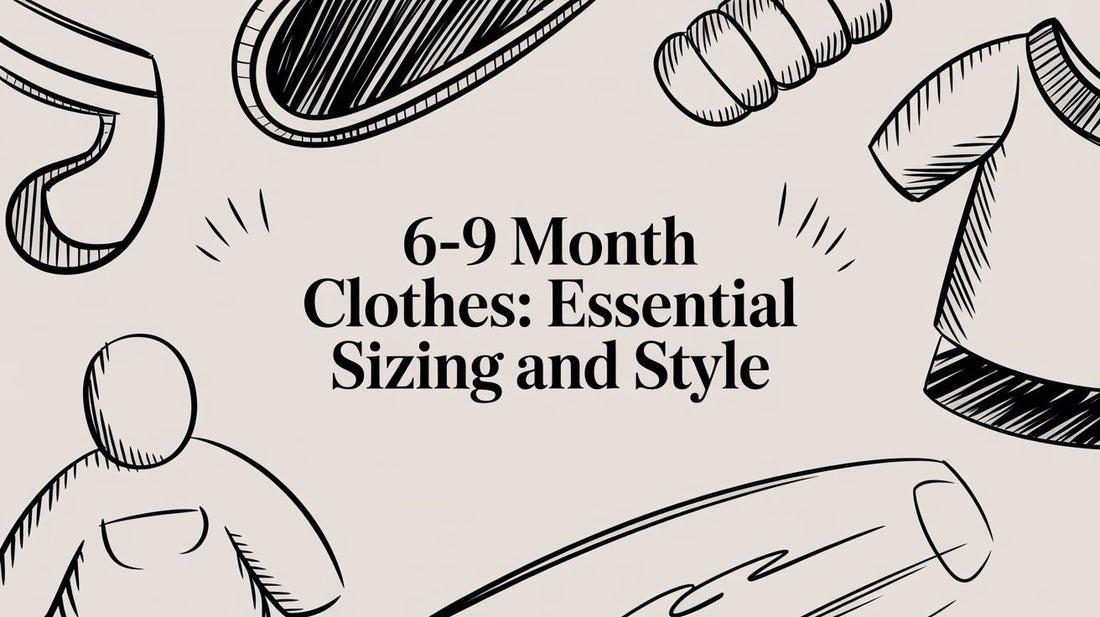
When you start shopping for 6–9 month clothes, you're entering a whole new world of dressing your baby. They're likely more active now—sitting up, maybe even starting to crawl—and their little personality is really beginning to shine through.
This size range is generally designed for babies weighing between 14 to 20 pounds and measuring 26 to 29 inches long. Of course, every baby is on their own unique growth schedule, so think of these numbers as a helpful starting point, not a strict rule.
Decoding the 6-9 Month Clothes Size Chart
Let's be honest, figuring out baby clothes sizes can feel like cracking a secret code. Different brands seem to play by their own rules, and that "6–9 month" tag is more of an estimate based on average milestones. The best guide you have is your own baby's growth.
Relying on your little one's actual measurements, rather than just their age, is the key to getting a comfortable and safe fit. It helps you avoid outfits that are too restrictive or dangerously baggy.
Here's a quick look at the standard measurements for this size range, comparing both US and European sizing conventions.
Standard 6-9 Month Size Chart Guide
| Measurement | US Size (6-9M) | EU Size (68-74) |
|---|---|---|
| Weight | 14-20 lbs (6.4-9.1 kg) | N/A |
| Height/Length | 26-29 in | 26.5-29 in (68-74 cm) |
As you can see, the biggest difference is that US sizes lean heavily on both weight and height, while European sizes are almost entirely based on the baby's length in centimeters. Keep that in mind when you're exploring brands from overseas!
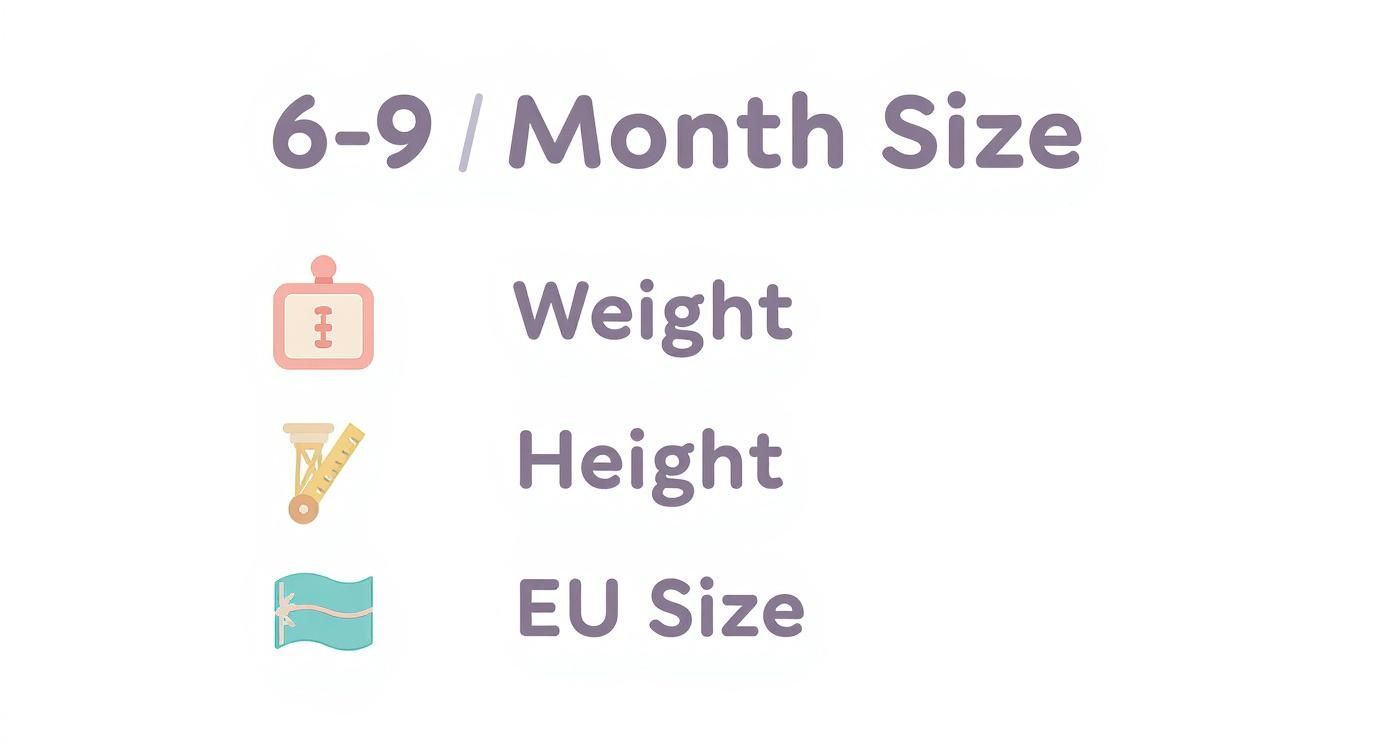
Measuring Your Baby for the Perfect Fit
Getting accurate measurements at home is easier than you might think. All you need is a soft, flexible measuring tape.
- Height/Length: Lay your baby down on a flat, comfortable surface. Gently stretch them out and measure from the very top of their head to the bottom of their heel.
- Weight: A baby scale will give you the most precise number. If you don't have one, a simple trick is to weigh yourself first, then weigh yourself again while holding your baby. The difference between the two numbers is your baby's weight.
A Quick Tip: Always remember that size charts are just a guide. Since there's no universal, mandatory standard for baby clothes, one brand's 6-9M outfit might fit just like another's 3-6M size. It's always a smart move to glance at a specific brand's size guide before you buy.
Checking your baby's measurements against a brand's chart will give you the confidence that you're picking the right size. For a more detailed look at how different brands handle sizing, check out our guide on understanding children's clothing sizes. A little extra knowledge here can save you a lot of hassle with returns and ensure every piece you buy gets plenty of wear.
Essential Pieces for Your 6-9 Month Old's Wardrobe
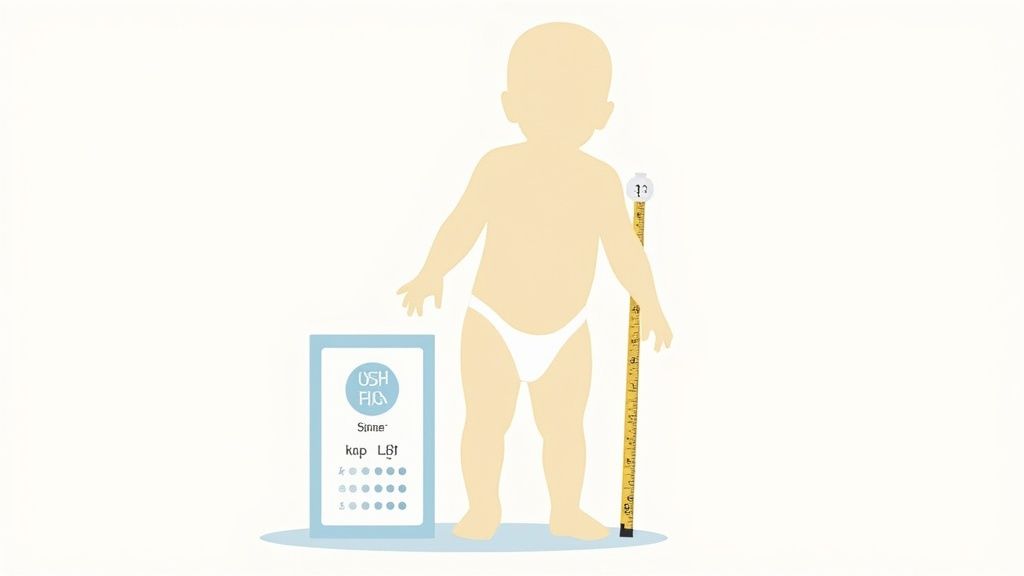
Now that your baby is getting more active, their clothes need to be ready for action. Building a smart collection of 6-9 month clothes isn't about having a mountain of outfits; it's about having the right foundational pieces. Think of it like a capsule wardrobe for your little one—versatile basics you can mix and match for any adventure.
This approach is all about practicality. You’ll be prepared for everything from messy mealtimes to cozy naps without a fuss. It's no surprise the baby clothing market was valued at a whopping $78.53 billion in 2023. Parents consistently gravitate toward comfortable, easy-to-wear styles like bodysuits and rompers because they just make life simpler. You can dive deeper into the growing baby clothing market on verifiedmarketresearch.com.
Core Wardrobe Staples
Let's start with the items that will handle the daily demands of a baby on the move. These pieces are the true backbone of their closet, designed for ultimate comfort and convenience.
- Bodysuits (8–10): Honestly, these are the MVPs of baby clothes. The snaps at the crotch are a lifesaver for quick diaper changes. Keep a mix of short-sleeve and long-sleeve options on hand, and you'll be ready for any weather.
- Pants and Leggings (5–7 pairs): Soft, stretchy bottoms are an absolute must for all that wiggling and crawling. They pull on easily over a bodysuit to make a complete outfit and give those little knees some extra padding during floor time.
- Sleepers and Sleep Sacks (4–6): For safe and sound sleep, you can't beat footed pajamas or wearable blankets. They keep your baby perfectly warm and cozy without the safety risks of loose blankets in the crib.
These numbers are a solid starting point. It's enough to get you through a few days between laundry cycles without scrambling for something clean.
My best tip? Build the wardrobe around a simple color palette. If you stick with a few neutrals—like gray, cream, or navy—and then add a few fun prints or pops of color, everything will mix and match effortlessly. No more outfit dilemmas before you've even had coffee.
Outerwear and Accessories
Once you've got the basics covered, a few extra pieces will round out the wardrobe. These will keep your baby comfortable during outings and those unpredictable weather changes.
- Light Jackets or Sweaters (2–3): A simple zip-up hoodie or a soft cardigan is perfect for layering. They’re great for breezy days or when you walk into a store with the AC blasting.
- Socks (6–8 pairs): You can never have too many socks! Look for pairs with grippers on the bottom. They’ll give your baby a little extra traction as they start pulling up and testing their balance.
- Soft-Soled Shoes (1-2 pairs): While they aren't walking just yet, a pair of soft shoes can protect tiny feet when you're outside. Plus, they complete an outfit without getting in the way of their natural foot movement.
Choosing the Best Fabrics for 6-9 Month Baby Clothes
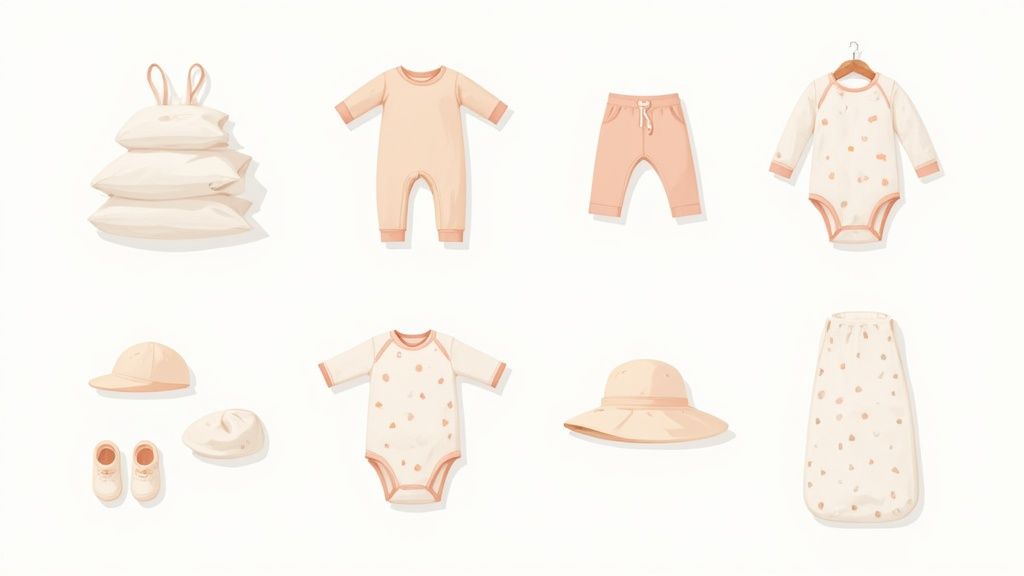
A baby's skin is unbelievably delicate, so the fabric you choose for their 6-9 month clothes is more than just a style choice—it's about comfort and care. Think of their outfits as a second skin. It needs to be soft, breathable, and completely free of anything that could cause irritation.
Without a doubt, the undisputed champion here is organic cotton. It’s grown without any harsh pesticides or synthetic fertilizers, making it naturally hypoallergenic and incredibly gentle. This is why it’s the perfect go-to for everyday essentials like bodysuits and sleepers, keeping your baby comfy around the clock.
Top Fabric Choices for Sensitive Skin
While organic cotton is king, a few other natural materials are fantastic options for your little one's wardrobe. They all share the same key benefits: softness, breathability, and the ability to keep your baby happy.
- Bamboo Rayon: This fabric has a silky-smooth feel that parents love. It's also super absorbent and wicks moisture away, which is a game-changer for preventing heat rash and keeping your baby dry.
- Merino Wool: Don't let the word "wool" scare you! Merino is an ultra-fine fiber that’s brilliant at regulating body temperature. It keeps your baby cozy when it's cool and comfortable when it's warm, all without a hint of itchiness.
Key Takeaway: Always lean towards natural, breathable fibers over synthetics like polyester or nylon. Synthetic fabrics tend to trap heat and moisture against the skin, which can easily lead to irritation and discomfort, especially for an increasingly active baby.
Understanding Labels and Eco-Friendly Trends
Getting into the habit of reading clothing labels is a smart move. Look for certifications like GOTS (Global Organic Textile Standard), which guarantees the fabric is truly organic and was produced ethically.
This shift toward natural materials isn't just a niche interest; it's a massive trend. The global organic baby clothing market was valued at $2.02 billion in 2024 and is expected to grow to $3.39 billion by 2032. It just goes to show how much parents are prioritizing chemical-free clothing for their kids. If you're curious, you can explore the full research on the baby clothing market.
Of course, once you've invested in these lovely fabrics, you'll want them to last. For the best tips on washing and maintaining these gentle garments, take a look at our guide on how to care for your child's clothes.
Styling Your 6-9 Month Old for Every Season
As the seasons turn, so does your baby's wardrobe. Dressing your little one for the weather isn't just a matter of looking cute—it's about keeping them comfortable and safe, whether you're heading to a sunny park picnic or just cuddling up indoors on a chilly day.
Warm Weather Wins: Keeping Cool and Protected
When the sun is shining, the name of the game is keeping your baby cool and protected. Think light, airy, and breathable.
- Sunsuits and Rompers: You really can't go wrong with a one-piece outfit made from soft, organic cotton. They’re a lifesaver for easy changes and give your baby plenty of room to wiggle, crawl, and explore.
- A Good Hat: A wide-brimmed sun hat is an absolute must-have for any time spent outdoors. It's the best way to shield their delicate face, neck, and little ears from the sun.
- UPF-Rated Gear: If you're planning a beach day or a long afternoon outside, look for swimwear or clothing with a UPF (Ultraviolet Protection Factor) rating. It’s like sunscreen you can wear.
Chilly Days: The Art of Layering
Once the temperature drops, layering is your best friend. The trick is to keep your baby warm without letting them get too warm, which is a key safety tip to remember. A simple three-layer approach usually does the trick perfectly.
A great rule of thumb is to dress your baby in one more thin layer than you’re comfortably wearing. It’s a simple gut check that helps you find that "just right" temperature for them.
Here’s how you can build the perfect cozy outfit for a cooler day:
- The Base Layer: Start with a soft, long-sleeved bodysuit. This first layer sits right against their skin, so you want something breathable like cotton that will keep them dry and comfy.
- The Middle Layer: Next, add an insulating layer for warmth. This could be a cozy fleece zip-up, a soft knit sweater, or a pair of warm leggings. This is the layer that really traps their body heat.
- The Outer Layer: For those truly cold, windy, or snowy days, a puffer jacket or an insulated bunting is what you'll need. Just remember to take any bulky coats off before buckling your baby into their car seat—the straps need to fit snugly against their chest for safety.
This layering system makes it so easy to adapt to changing temperatures. Pop into a warm coffee shop? Just slip off the outer layer. Back out into the cold? Zip it back up. It ensures your little one stays perfectly comfortable, no matter where your day takes you.
Smart Shopping Tips for 6-9 Month Clothes
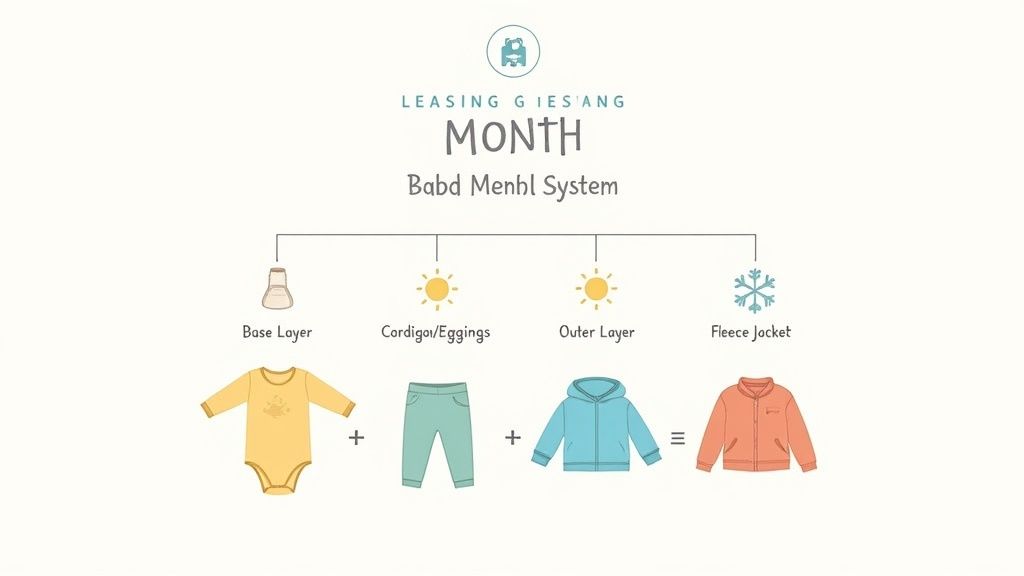
Let's be real—babies grow at lightning speed. One minute they fit perfectly, and the next, you're wrestling them out of a onesie that's suddenly too snug. Shopping smart for 6-9 month clothes is all about striking the right balance to keep your budget happy.
The trick is knowing where to spend and where to save. For those high-use workhorses like a quality sleep sack or a super-durable play mat, investing a little extra in something built to last really pays off.
But for the everyday bodysuits, leggings, and rompers they'll likely outgrow in a few months? Multi-packs from affordable brands are your best friend. This practical approach gives you reliable essentials without breaking the bank on items with a seriously short shelf life. For more tips on building a smart wardrobe, our baby shopping list for first-time moms is a great place to start.
Master the Art of Thrifty Finds
Secondhand clothing isn't just budget-friendly; it's a goldmine for adorable, barely-worn outfits. When you're sifting through the racks, just keep a few key things in mind to ensure you're getting safe, quality pieces.
- Inspect Closures: Give every snap, zipper, and button a quick check. Make sure they're secure and working smoothly. You'll want to avoid anything with loose parts that could become a hazard.
- Check Seams: A quick tug on the seams will tell you if a garment is ready for an active, crawling baby. Look for stitching that’s strong and fully intact.
- Give it a Sniff: Trust your nose. If something has a strong musty or chemical smell, it's best to pass. And, of course, always wash any pre-loved finds in a gentle, baby-safe detergent before their first wear.
A brilliant long-term strategy is to stick with gender-neutral basics. Pieces in versatile colors like gray, cream, or sage green can easily be passed down to future siblings, stretching their value well beyond one child’s wardrobe.
Time Your Purchases Strategically
When it comes to baby clothes, timing is everything. You can score amazing deals by shopping off-season. Think about buying winter gear in the spring or grabbing next year's summer clothes in the fall—this is when you'll find deep discounts on top brands.
The global market for babies' garments is huge and expected to reach $150 billion by 2025, with online shopping leading the charge. E-commerce has opened up a world of options for parents, making it easier than ever to compare prices and hunt down the best deals from the comfort of your couch.
Answering Your Questions About 6–9 Month Clothes
As your baby gets bigger and more active, you're bound to have questions about their wardrobe. It's a stage full of rapid changes, so let's tackle some of the most common things parents wonder about.
How Many Outfits Do I Need a Day for a 6–9 Month Old?
At this age, babies are little mess-making machines. Between drool, spit-up, and those first forays into solid foods, things get messy, fast. I always tell parents to plan on at least two to three full outfit changes every day.
It’s a good idea to have a few clean bodysuits and a couple of pairs of pants or rompers on standby. A few extra backups tucked in the drawer never hurt, either!
Should I Buy 6–9 Month Clothes Ahead of Time?
It’s so tempting to stock up when you see a great sale, but I’d hold off just a bit. Every baby's growth is different, and they can hit a growth spurt completely out of the blue. You don't want to end up with a drawer full of adorable clothes that never get worn.
A great little trick is to buy just the basics ahead of time. Think plain bodysuits or a cozy sleep sack in the next size up. This way, you save a little money without gambling on sizes or seasons.
What Safety Features Should I Look For?
Nothing is more important than safety, especially when it comes to what your little one wears. When you're shopping for 6-9 month clothes, keep an eye out for a few key things.
- No small parts: Avoid clothes with little beads, sequins, or buttons that could pop off. These can easily become a choking hazard.
- Skip the drawstrings: Any clothing with drawstrings, like hoodies or some pants, can be a serious strangulation risk. It's best to steer clear of them entirely.
- Pick snug-fitting sleepwear: Pajamas should fit closely to your baby’s body. This is part of safe sleep guidelines and helps reduce fire risk.
How Do I Keep Baby Clothes in Good Shape?
A gentle laundry routine is your best friend for keeping those tiny outfits soft and looking new. Make sure to wash everything before its first wear with a mild, baby-friendly detergent that’s free of harsh fragrances.
For the best results, turn clothes inside out before washing, stick to a cold water cycle, and let them air-dry if you can. This simple routine really helps prevent shrinking and fading, so you can get the most out of every single piece.
At Yarafly, LLC, we get it. We design our clothes to be durable, safe, and cute, helping make laundry day just a little easier for busy parents. You can check out our collection of soft, practical styles for your growing baby right here: https://yarafly.com.